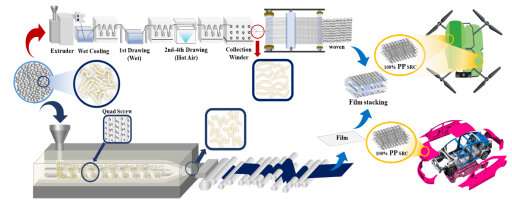SRCs) are inexpensive, lightweight, and have advantages in terms of disposal and recycling as the reinforcement and the base material are composed of the same material. For this reason, it is attracting attention as a next-generation composite material to replace carbon fiber-reinforced composites used in aircraft.
The Korea Institute of Science and Technology (KIST) has announced that Dr. Jaewoo Kim of the Solutions to Electromagnetic Interference in Future-mobility (SEIF), together with Prof. Seonghoon Kim of Hanyang University and Prof. O-bong Yang of Jeonbuk National University have successfully developed a 100% SRC using only one type of polypropylene (PP) polymer. Their work is published in the Chemical Engineering Journal.

Until now, in the manufacturing process of SRCs, chemically different components have been mixed in the reinforcement or matrix to improve fluidity and impregnation, resulting in poor physical properties and recyclability. The research team succeeded in controlling the melting point, fluidity, and impregnation by adjusting the chain structure of the polypropylene matrix through a four-axis extrusion process.
The developed SRCs achieved the highest level of mechanical properties, with adhesion strength, tensile strength, and impact resistance improved by 333%, 228%, and 2,700%, respectively, compared to previous studies. When applied as a frame material for a small drone, the material was 52% lighter than conventional carbon fiber reinforced composites and the flight time increased by 27%, confirming its potential for next-generation mobility applications.
Dr. Kim of KIST said, “The engineering process for 100% SRCs developed in this study can be immediately applied to industry, and we will continue to work with the joint research team and industries to secure the global competitiveness of magnetically reinforced composites.”
More information: Hyeseong Lee et al, True self-reinforced composites enabled by tuning of molecular structure for lightweight structural materials in future mobility, Chemical Engineering Journal (2023). DOI: 10.1016/j.cej.2023.142996
Provided by National Research Council of Science & Technology

